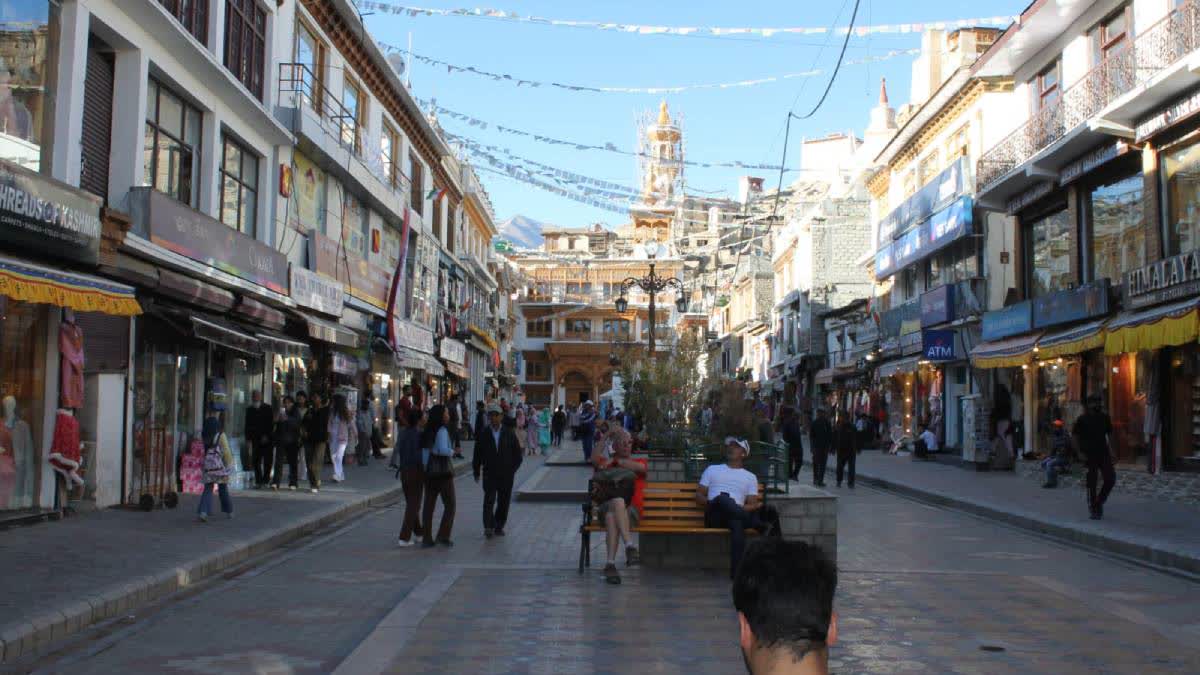Leh (Ladakh): After a lull, Ladakh is witnessing a steady rise in international tourist footfalls, while the domestic tourist count has declined this year.
According to the data from the Office of Assistant Director, Tourism Department, Leh, a total of 5.31 lakh tourists visited Ladakh in 2022, out of which 21,259 were foreigners and 5.1 lakh were Indians. Similarly, in 2023, a total of 5.25 lakh tourists comprising 36,315 foreigners and 4.9 lakh Indian tourists visited the Union Territory. The headcount till August this year was nearly 3 lakh including 30,921 foreigners and 2.7 lakh from within the country.
As per the Deputy Commissioner’s office, a total of 2.9 lakh permits were issued to domestic tourists and 39,240 permits for foreign tourists till September 25.
This year, the number of Israeli tourists has spiked, contributing to a broader trend of increasing foreign footfall. Travel agents attribute this rise to Ladakh’s growing reputation as a destination for offbeat and serene travel, coupled with the relaxation of travel restrictions after the pandemic.
Tsering Motup of Changspa area in Leh said, “The influx of tourists keeps on fluctuating in Ladakh. Domestic tourist visits Ladakh in April, May and June while international tourists start coming in July. We can see a lot of international tourists in the Changspa area particularly from Israel. Earlier, we were doubtful about their arrival because of the ongoing war. But we see a lot of Israelis this year. Changspa area is known among the Israelis and we also have a Jewish House there known as Chabad House where they gather to pray. The Chabad House has been here for almost 10 years. They come and stay here for months with their families. They have centres in Delhi and other places as well. They have been coming to Ladakh for many years. At present, India has good relations with Israel which is why a lot of people from Israel visit different places of India considering it one of the safest places to visit. Every Friday and Saturday, they gather and pray.”
Motup said many war-fatigue Israelis visit the Turtuk area to relax by the river in Turtuk.
“Israeli tourists are showing a strong preference for the remote and tranquil environment that Ladakh offers. They are seeking immersive experiences, trekking, and cultural exploration," Imtiyaz Ahmed, a travel agent in Leh, said.
On the flip side, Ladakh has experienced a downward spiral in domestic tourist count, which is attributed to various factors like economic constraints, changing travel preferences, and the popularity of alternative destinations, particularly in South Asian countries.
“Ladakh is an expensive tourist destination in terms of transportation and stay. Another reason is the steep airfare. Domestic tourists are more interested in sightseeing like visiting Nubra, Pangong etc. than mountaineering,” Ahmed said.
Many believe that the shift in tourist trends may also be influenced by international travellers seeking quieter, less crowded destinations, while domestic tourists are opting for more accessible or cost-effective vacation spots. The relative remoteness of Ladakh and the higher costs of travel and stay may have also contributed to the decline.
"We are seeing fewer Indian tourists compared to the previous seasons, said, Tenzin Dorjee, a travel agent owner in Leh.
With the changing trends of tourism, Ladakh’s charm continues to lure a diverse crowd, but local businesses are keen to see sustainable growth.
Tenzin Dorjee, a travel agent, said, “Two years back, the influx of domestic tourists was more but this time we see a lot of international tourists. We are seeing a lot of walking clients including Israelis. In the last two years, we have organised tours for almost 20-30 groups including trekking, climbing, mountaineering and sightseeing. During Covid, the number of international tourists dipped. However, Israelis come in groups and do not interact with other European tourists. They create WhatsApp groups and organise tours themselves.
“Another thing I noticed is the degradation of the quality of Tourism year after year. Tourists from Israel go to the Markha Valley without a guide. The Tourism stakeholders should take proactive action and issue a notice making guides mandatory for these places. For example, in places like Nepal and Bhutan, one cannot visit places without a guide. Markha is a beautiful place but is not getting the value it deserves. Ladakh has a lot of potential for tourism but we need to promote quality tourism. We need to focus on the management,” Dorjee added.
Ahmad said this year a lot of international tourists have dropped by in July and August while domestic tourists come at the beginning and end of the tourist season. The number of Israeli tourists has declined by 40 per cent due to the ongoing war. International tourists prefer places where the crowd is less. Last year, there were five instances where they lost the trail or had high altitude issues. There should be some checks on it by the stakeholders as travel agents cannot stop them.
“In 2023-24, we had organised tours for 500 international tourists out of which 400 were from Israel. And this year also we have organised tours for 500 foreigners out of which 300 were Israelis,” Ahmad said.
“I do not know whether it is true or not, but I heard that the Israeli government provided money to their people to move out from there and with that money they came for vacation. We had organised more tours, trekking and expeditions for international tourists than their domestic counterparts. Last year too, we saw similar trends. On the contrary, we see a lot of domestic self-driven cars and bikers. Most of the domestic tourists visit Nubra and Umlingla, the highest motorable pass in the world,” Tsering Dadul, manager of a travel agency in Leh, said.
Also Read:
- Jaishankar Admits 'Difficult History' With China, but Welcomes Troops Disengagement
- Ladakh Festival Begins in Leh; Reflects Rich Culture and Heritage
